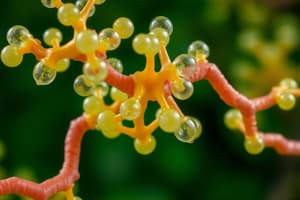Podcast
Questions and Answers
What effect does the attachment of sugars to small metabolites have on their molecular weight and melting point?
What effect does the attachment of sugars to small metabolites have on their molecular weight and melting point?
- Decrease
- Alter
- Increase (correct)
- No effect
What is the function of cyanogenic glycosides in plants?
What is the function of cyanogenic glycosides in plants?
- Promote photosynthesis
- Enhance plant growth
- Detoxify harmful molecules (correct)
- Increase toxicity
What severe pathology can cyanogenic glycosides cause when consumed?
What severe pathology can cyanogenic glycosides cause when consumed?
- Severe neurological issues
- Digestive problems (correct)
- Respiratory infections
- Skin rashes
What is the significance of understanding the biosynthesis and function of glycosides?
What is the significance of understanding the biosynthesis and function of glycosides?
How do glycosylated metabolites assist in the transport across cell membranes?
How do glycosylated metabolites assist in the transport across cell membranes?
What can be released from volatile compounds after hydrolysis?
What can be released from volatile compounds after hydrolysis?
What is the primary role of glycosides in biological processes?
What is the primary role of glycosides in biological processes?
What is the process of breaking the glycosidic bond in a glycoside?
What is the process of breaking the glycosidic bond in a glycoside?
Where are natural glycosides commonly found in nature?
Where are natural glycosides commonly found in nature?
What is one example of a glycoside that is derived from steviol?
What is one example of a glycoside that is derived from steviol?
How do glycosides improve the bio-distribution and metabolism of hydrophobic metabolites?
How do glycosides improve the bio-distribution and metabolism of hydrophobic metabolites?
What is the primary function of glycosides in plants?
What is the primary function of glycosides in plants?
Study Notes
Glycosides
Glycosides are a diverse group of compounds that contain a carbohydrate molecule attached to a non-carbohydrate counterpart. They play a significant role in various biological processes, including cell signaling, drug action, and the synthesis of complex molecules. The glycosidic bond is the link between the sugar and the non-sugar component, and hydrolysis is the process of breaking this bond by the addition of water.
Glycosides in Nature
Natural glycosides are found in many enzymes and glycoproteins, where sugars are linked to proteins by O-glycosidic bonds. Glycosides are also used as medications, and their effects can be modulated by biological enzymes through hydrolysis, which activates the molecule and allows it to interact with intracellular targets like glycoside-linked signal transduction proteins.
Biosynthesis of Glycosides
The biosynthesis of glycosides is a complex process involving several steps. One example is the biosynthesis of steviol glycosides, which are derived from steviol and generated via the 2-C-methyl-d-erythritol-4-phosphate (MEP) pathway. Steviol glycosides have been studied for their potential therapeutic applications due to their sweet taste and low caloric content.
Importance of Glycosides in Plants
Glycosides are essential for plants, serving multiple purposes. They improve the bio-distribution and metabolism of hydrophobic metabolites by making them more water-soluble. Increased solubility and amphiphilicity of glycosylated metabolites also assist their transport across cell membranes. The attachment of sugars to small metabolites raises their molecular weight and melting point, allowing synthesis and storage of precursors of volatile compounds that can be released on demand after hydrolysis.
Examples of Glycosides
Cyanogenic glycosides are a type of glycoside found in plants, consisting of an α-hydroxynitrile group attached to a sugar moiety. These glycosides can detoxify harmful molecules by generating non-toxic agents that can later be re-activated and used as aglycone in defense against parasites. Cyanogenic glycosides are ubiquitous in plants and can cause severe pathology when consumed, such as in the case of cassava (Musa esculenta) and its cyanogenic glycosides linamarin and lotaustralin.
In summary, glycosides play a vital role in various biological processes and have significant applications in medicine and agriculture. Understanding their biosynthesis and function is crucial for developing new therapeutics and optimizing plant-derived products.
Studying That Suits You
Use AI to generate personalized quizzes and flashcards to suit your learning preferences.
Description
Explore the world of glycosides, compounds composed of a carbohydrate linked to a non-carbohydrate molecule. Learn about their role in biology, including cell signaling and drug actions, as well as their significance in medicinal and agricultural applications. Delve into the biosynthesis of glycosides and their importance in plants.




